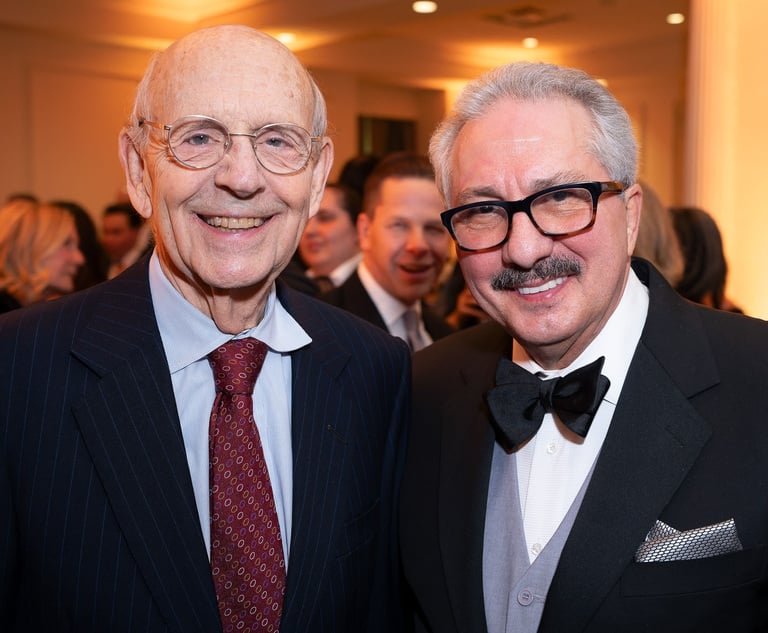 Presiding Justice Gerald J. Whalen
Presiding Justice Gerald J. Whalen The Right Words Promote Thoughtful Discourse
Gerald J. Whalen, Presiding Justice of the Appellate Division, Fourth Department, writes: When we find the right words, we invite more reasoned, but no less passionate, advocacy from our colleagues in the bar. When we find the right words, the decisions we render transcend utilitarian determinations and become beacons.
January 17, 2023 at 10:15 AM
4 minute read
As attorneys, as judges, as people, we are forever in pursuit of the right words. Many a CLE has been devoted to a question-and-answer session with judges focused on what they look for in a motion or brief. What techniques do the judges find persuasive? How can counsel keep a high-volume judicial reader engaged? What degree of ire will the use of footnotes provoke? Judges' answers inevitably reflect differences of opinion: One judge reads a reply brief first on the belief that it will reflect the most distilled version of the issues to be determined and another finds that a reply brief rarely adds new value. Many judges find a narrative structure helps with factual digestion, others warn against sacrificing clarity for the sake of story. Despite the differences in opinion, or perhaps because of them, this discourse helps promote more thoughtful and purposeful writing from advocates, which benefits both the bench and the bar.
Quality writing from counsel is only part of the equation, however, and judges can benefit just as much as the bar from taking the time to revisit the fundamentals that underlie our own writing. Indeed, in our efforts to untangle the issues with which we are presented, it is possible to forget that we write not only to resolve the immediate disputes raised by the litigants, but to provide guidance to the bar, transparency for our determinations, and, yes, even to persuade others as to the correctness of our resolutions. Self-reflection reminds us that our audience includes not just the attorneys who appear before us, each of whom speaks the same legal language in which we were trained. It also includes their clients, courts for which our decisions will serve as binding precedent, courts that will review our determinations, and the public in general. Each writing weaves itself into our common law system of justice and becomes a permanent part of that fabric. The better the writing, the stronger the thread.
This content has been archived. It is available through our partners, LexisNexis® and Bloomberg Law.
To view this content, please continue to their sites.
Not a Lexis Subscriber?
Subscribe Now
Not a Bloomberg Law Subscriber?
Subscribe Now
NOT FOR REPRINT
© 2025 ALM Global, LLC, All Rights Reserved. Request academic re-use from www.copyright.com. All other uses, submit a request to [email protected]. For more information visit Asset & Logo Licensing.
You Might Like
View All
Legal Community Luminaries Honored at New York State Bar Association’s Annual Meeting

Looking to the Future of the FDA and Its Impact on Drug Regulation in 2025
4 minute readTrending Stories
Who Got The Work
J. Brugh Lower of Gibbons has entered an appearance for industrial equipment supplier Devco Corporation in a pending trademark infringement lawsuit. The suit, accusing the defendant of selling knock-off Graco products, was filed Dec. 18 in New Jersey District Court by Rivkin Radler on behalf of Graco Inc. and Graco Minnesota. The case, assigned to U.S. District Judge Zahid N. Quraishi, is 3:24-cv-11294, Graco Inc. et al v. Devco Corporation.
Who Got The Work
Rebecca Maller-Stein and Kent A. Yalowitz of Arnold & Porter Kaye Scholer have entered their appearances for Hanaco Venture Capital and its executives, Lior Prosor and David Frankel, in a pending securities lawsuit. The action, filed on Dec. 24 in New York Southern District Court by Zell, Aron & Co. on behalf of Goldeneye Advisors, accuses the defendants of negligently and fraudulently managing the plaintiff's $1 million investment. The case, assigned to U.S. District Judge Vernon S. Broderick, is 1:24-cv-09918, Goldeneye Advisors, LLC v. Hanaco Venture Capital, Ltd. et al.
Who Got The Work
Attorneys from A&O Shearman has stepped in as defense counsel for Toronto-Dominion Bank and other defendants in a pending securities class action. The suit, filed Dec. 11 in New York Southern District Court by Bleichmar Fonti & Auld, accuses the defendants of concealing the bank's 'pervasive' deficiencies in regards to its compliance with the Bank Secrecy Act and the quality of its anti-money laundering controls. The case, assigned to U.S. District Judge Arun Subramanian, is 1:24-cv-09445, Gonzalez v. The Toronto-Dominion Bank et al.
Who Got The Work
Crown Castle International, a Pennsylvania company providing shared communications infrastructure, has turned to Luke D. Wolf of Gordon Rees Scully Mansukhani to fend off a pending breach-of-contract lawsuit. The court action, filed Nov. 25 in Michigan Eastern District Court by Hooper Hathaway PC on behalf of The Town Residences LLC, accuses Crown Castle of failing to transfer approximately $30,000 in utility payments from T-Mobile in breach of a roof-top lease and assignment agreement. The case, assigned to U.S. District Judge Susan K. Declercq, is 2:24-cv-13131, The Town Residences LLC v. T-Mobile US, Inc. et al.
Who Got The Work
Wilfred P. Coronato and Daniel M. Schwartz of McCarter & English have stepped in as defense counsel to Electrolux Home Products Inc. in a pending product liability lawsuit. The court action, filed Nov. 26 in New York Eastern District Court by Poulos Lopiccolo PC and Nagel Rice LLP on behalf of David Stern, alleges that the defendant's refrigerators’ drawers and shelving repeatedly break and fall apart within months after purchase. The case, assigned to U.S. District Judge Joan M. Azrack, is 2:24-cv-08204, Stern v. Electrolux Home Products, Inc.
Featured Firms
Law Offices of Gary Martin Hays & Associates, P.C.
(470) 294-1674
Law Offices of Mark E. Salomone
(857) 444-6468
Smith & Hassler
(713) 739-1250








